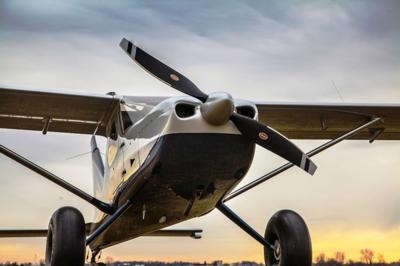Tue, Mar 18, 2014
Two- And Three-Blade Versions 'Designed To Maximize Performance' Company Says
Hartzell Propeller is introducing two- and three-blade versions of its new swept-tip Trailblazer prop for experimental aircraft and a number of certificated aircraft models.

“I put the new Hartzell Trailblazer prop on my Sportsman for increased performance that backcountry flying demands. Backcountry flying is all about getting into remote landing areas, but once you’re in you have to get back out,” said Hartzell Propeller President Joe Brown. “The takeoff acceleration and climb performance of the new Trailblazer prop gives me the added performance I want for backcountry flying.”
The new Hartzell Trailblazer swept-tip propellers are designed to maximize performance of the numerous aircraft, both certified and amateur built, specifically designed for bush and backcountry flying. The two-blade version is compatible with most Lycoming 360 and 390 series engines, with no placards or restrictions. A three-blade version is available for higher horsepower applications. In addition, Hartzell Propeller is working with numerous aircraft manufacturers to pursue approvals to install the new Trailblazer propeller on certified aircraft.
The two-blade configuration of the Hartzell Trailblazer propeller is available in 78”, 80” and 83” diameters and the three-blade configuration in 80”, 82” and 85” diameters. All have unlimited blade life and are approximately 20 percent lighter than comparable propellers with aluminum blades. The swept-tip, scimitar shaped airfoil is designed for optimal take-off acceleration and climb performance, resulting in an increase of 80-100 fpm climb rate versus a three-blade wood core propeller. The thin, stiff airfoil design that is possible when utilizing aerospace composites allows improved low speed thrust while achieving a three-knot cruise speed improvement over wood core props.
The Hartzell Trailblazer’s all carbon fiber construction features an innovative mesh erosion shield and field replaceable nickel-cobalt leading edge ensuring it can withstand demanding backcountry and bush flying. The carbon fiber structural composite construction is more than five to 10 times stronger than beech wood and spruce, respectively, and includes Hartzell’s state-of-art wedge shank blade retention design.
(Image provided by Hartzell)
More News
Terminal Radar Service Area Airspace surrounding designated airports wherein ATC provides radar vectoring, sequencing, and separation on a full-time basis for all IFR and participa>[...]
Aero Linx: Utah Back Country Pilots Association (UBCP) Through the sharing experiences, the UBCP has built upon a foundation of safe operating practices in some of the most challen>[...]
From 2010 (YouTube Edition): Imagine... Be The Change... Inspire FROM 2010: One of the more unusual phone calls I have ever received occurred a few years ago... from Anousheh Ansar>[...]
(Pilot) Felt A Shudder And Heard The Engine Sounding Differently, Followed By The Engine Chip Detector Light On April 14, 2025, about 1800 Pacific daylight time, a Bell 206B, N1667>[...]
Also: AMA Names Tyler Dobbs, More Falcon 9 Ops, Firefly Launch Unsuccessful, Autonomous F-16s The Air Force has begun ground testing a future uncrewed jet design in a milestone tow>[...]
 ANN's Daily Aero-Term (05.07.25): Terminal Radar Service Area
ANN's Daily Aero-Term (05.07.25): Terminal Radar Service Area ANN's Daily Aero-Linx (05.07.25)
ANN's Daily Aero-Linx (05.07.25) Classic Aero-TV: Anousheh Ansari -- The Woman Behind The Prize
Classic Aero-TV: Anousheh Ansari -- The Woman Behind The Prize NTSB Prelim: Bell 206B
NTSB Prelim: Bell 206B Airborne-NextGen 05.06.25: AF Uncrewed Fighters, Drones v Planes, Joby Crew Test
Airborne-NextGen 05.06.25: AF Uncrewed Fighters, Drones v Planes, Joby Crew Test



